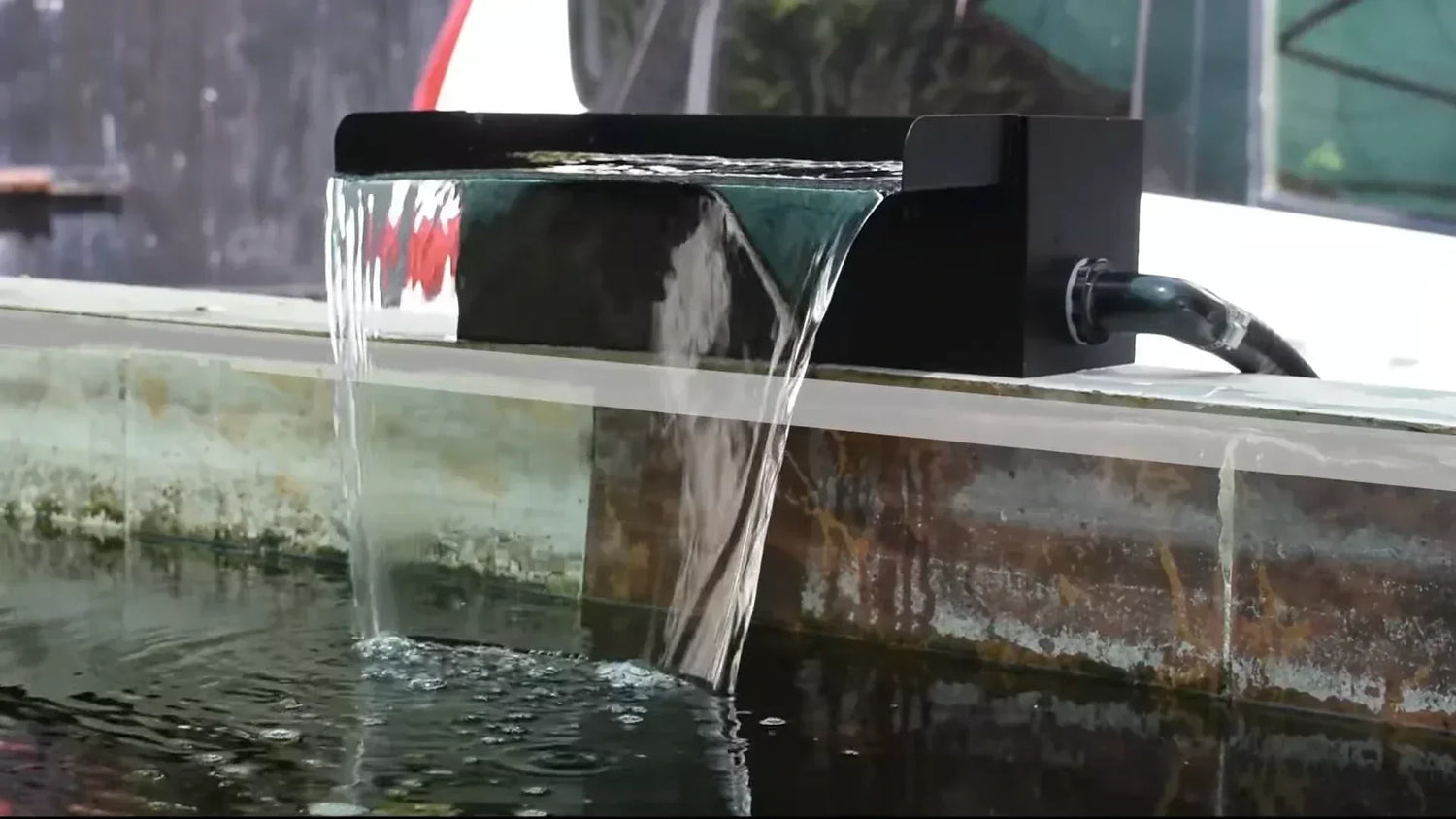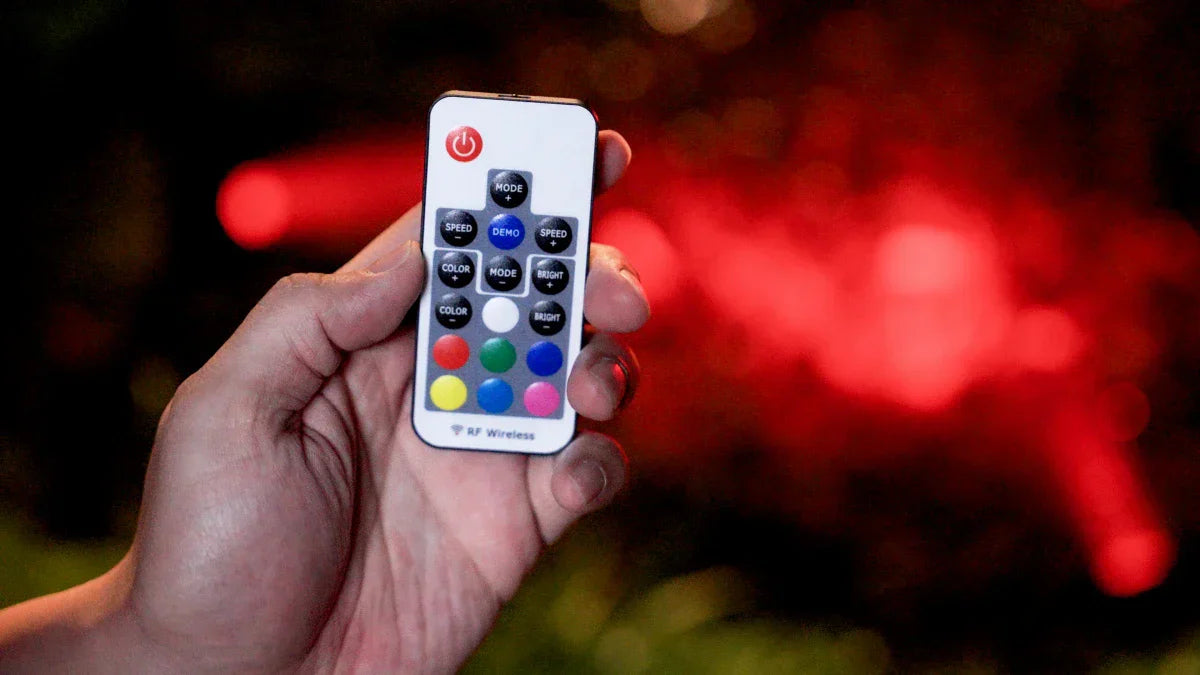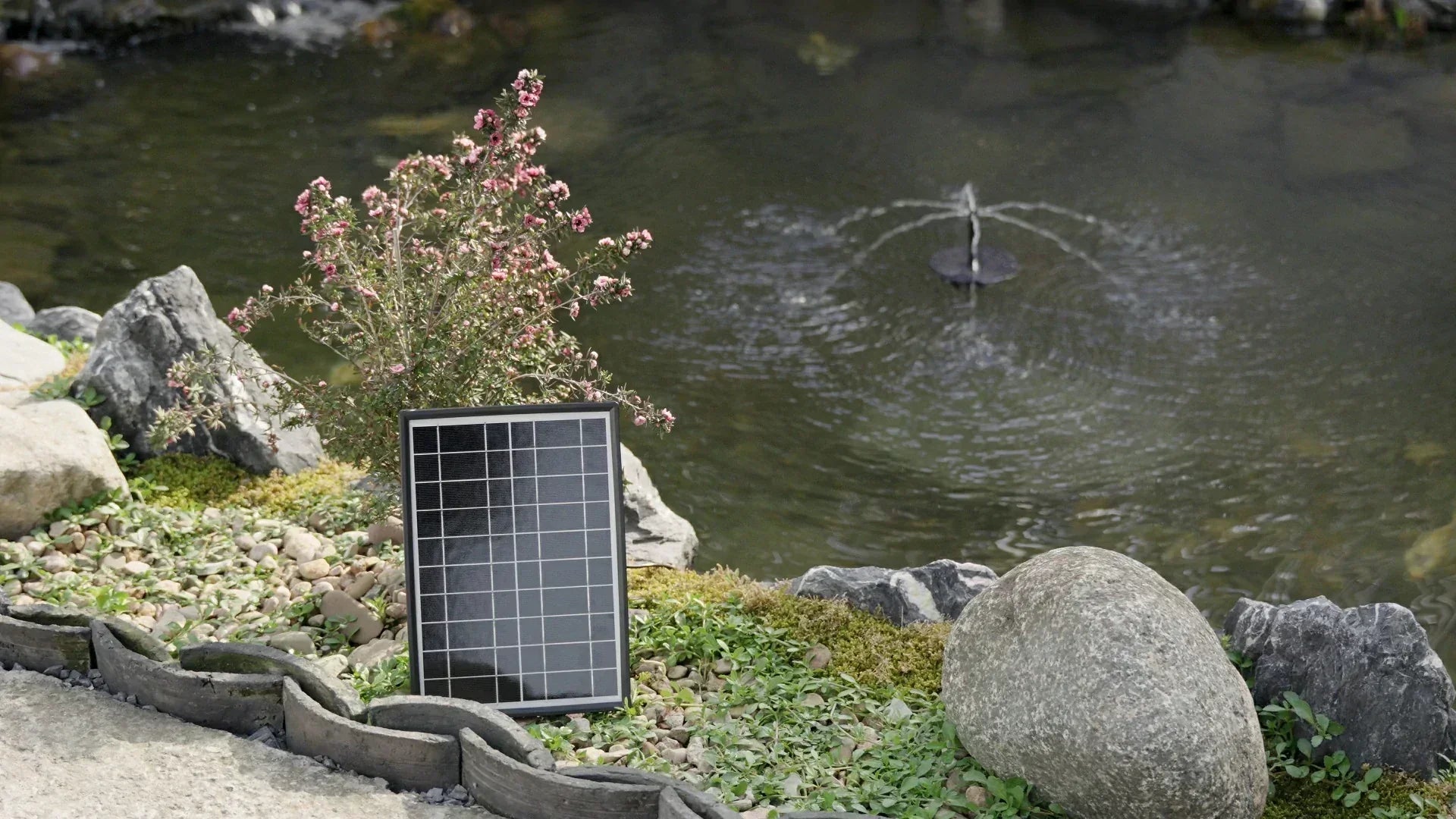Sie haben den Bachlauf skizziert, den Überlauf ausgewählt und können sich schon das sanfte Rauschen an Sommerabenden vorstellen. Doch dann kommen Zweifel: Reicht die Förderleistung einer Solarpumpe für einen schönen Wasserfall aus, besonders wenn Wolken aufziehen? Die kurze Antwort: Ja – vorausgesetzt, die Pumpe ist richtig dimensioniert und installiert. Im Folgenden erklären wir Ihnen die Funktionsweise von Solarpumpen, die Anforderungen an einen Wasserfall und die Ergebnisse von Vergleichstests. Abschließend geben wir Ihnen konkrete Empfehlungen – basierend auf den Solarbrunnen und -wasserfällen von Poposoap –, damit Ihr Traum vom Solarbrunnen Wirklichkeit wird.
Wie Solarpumpen funktionieren

Eine Solarpumpe ist eine bürstenlose Gleichstrompumpe, die direkt von einem Photovoltaikmodul (mit einem kleinen Regler) angetrieben wird. Trifft Sonnenlicht auf das Modul, treiben Spannung und Strom den Motor an; mehr Sonne bedeutet mehr Fördermenge und Förderhöhe (Druck). Viele moderne Sets ermöglichen es, das Modul auf einem Erdspieß zu befestigen und die Pumpe direkt am Teich zu platzieren; die Verbindung erfolgt über ein wetterfestes Kabel.
Wichtige Punkte für die Leistung:
- Direkte Sonneneinstrahlung = maximale Leistung. Bewölkung reduziert die Strömung, was Durchfluss und Förderhöhe verringert.
- Die Förderkennlinie ist wichtig. Jede Pumpe hat eine maximale Förderhöhe (die vertikale Höhe, die sie fördern kann). Mit steigender Förderhöhe sinkt der Durchfluss.
- Reibung spielt eine Rolle. Lange Schläuche, Winkelstücke und enge Rohre erhöhen den Widerstand und verringern den Durchfluss zusätzlich.
- Eine optionale Akku-Notstromversorgung kann kurze Wolkenperioden ausgleichen und den Betrieb am Abend ermöglichen.
Im Katalog von Poposoap finden sich Solarbrunnen- und Wasserfallsets mit einer Leistung von ca. 6–70 Watt, einem maximalen Durchfluss von ca. 80–680 Gallonen pro Stunde (GPH) und einer Förderhöhe von bis zu ca. 16 Fuß bei den leistungsstärkeren Modellen. Damit lassen sich sowohl kleine Zierbäche als auch kompakte Gartenwasserfälle realisieren – ganz ohne Stromleitungen verlegen oder Verlängerungskabel durch den Garten führen zu müssen.
Wasserfallhöhe und -durchfluss – Was Sie tatsächlich brauchen

Hier ist die ehrliche Logik hinter der Dimensionierung eines Solarpumpen-Wasserfalls, der optisch und akustisch stimmig ist:
- Vertikale Förderhöhe (statische Förderhöhe): Messen Sie von der Wasseroberfläche des Teichs bis zur Überlaufkante. Dies ist die minimale Förderhöhe, die Ihre Pumpe überwinden muss.
- Gewünschtes Aussehen des Wasserfilms: Für einen seidenweichen Wasserfall gilt als Faustregel eine Wassermenge von etwa 100 Gallonen pro Stunde (GPH) pro Zoll Überlaufbreite. Für einen sanfteren Wasserfluss genügen 50–60 GPH pro Zoll.
- Reibungsverluste: Rechnen Sie mit einer zusätzlichen Kapazität von 10–25 %, wenn Sie längere Schlauchstrecken (über ~10–15 Fuß), mehrere Winkelstücke oder kleinere als die empfohlenen Schläuche verwenden.
Beispiele:
- Schmaler 8"-Überlauf bei 24"-Anstieg: Ziel ist eine Durchflussmenge von ca. 400–800 GPH bei dieser Fallhöhe (sanfte bis robuste Wasserführung).
- Bei einem Überlauf von 12 Zoll und einer Steigung von 30 Zoll sollte eine Durchflussmenge von ca. 600–1.200 GPH angestrebt werden.
- Bei einem Überlauf von 18 Zoll und einer Steigung von 36 Zoll befinden Sie sich im Bereich großer Wassermengen; bei einem starken Wasservorrat sind mindestens ~1.000–1.800 GPH am Überlaufkopf typisch.
Da die Fördermenge mit zunehmender Förderhöhe abnimmt, sollten Pumpen nicht ausschließlich nach ihrer maximalen Fördermenge (in Litern pro Stunde) ausgewählt werden. Entscheidend ist die Fördermenge, die die Pumpe bei der tatsächlichen Förderhöhe liefert. Bei Solaranlagen zahlt es sich aus, die Breite und Höhe des Überlaufs realistisch einzuschätzen.
Feldtest: Was wir im Garten gesehen haben

Um die technischen Daten in Bild und Ton umzusetzen, haben wir drei realitätsnahe Szenarien mit Standard-Schlauchleitungen und einfachen Überläufen nachgebaut. Die Bedingungen entsprachen einem typisch sommerlichen Mischwetter – strahlender Sonnenschein mit vereinzelten leichten Wolken.
Szenario A – 2 Fuß Anstieg, 8 Zoll Überlauf
- Die Poposoap 30-Watt-Solarbrunnenpumpe erzeugte ein stetiges, ansprechendes Plätschern mit deutlichem Glitzern; bei voller Sonneneinstrahlung verdickte sich der Wasserfilm zur Mitte des Wehrs hin. Leichte Bewölkung sorgte für einen ruhigeren Wasserfilm, der jedoch weiterhin angenehm floss.
- Das Poposoap 55-Watt-Solarwasserfall-Set erzeugte bei Sonnenschein einen überzeugenden, nahezu durchgehenden Wasserfilm. Bei leichter Bewölkung wurde der Film zwar dünner, blieb aber dennoch stabil. Eine gute Wahl für einen kompakten, leisen Wasserfall ohne Netzanschluss.
Szenario B – 2,5 Fuß Anstieg, 12 Zoll Überlauf
- Poposoap 55-Watt Solar-Wasserfall-Set : Bei voller Sonneneinstrahlung erzeugte es ein angenehmes, hörbares Rauschen; bei leichter Bewölkung verringerte es sich auf ein sanfteres, unterbrochenes Rauschen – immer noch malerisch.
- Poposoap 70-Watt-Solar-Wasserfall-Set : Der gleichmäßige Wasserfilm blieb auch bei leichter Bewölkung erhalten und der Klang wirkte voller. Wenn Ihre Terrasse der Haupt-Hörbereich ist, klingt die 70-Watt-Variante an sonnigen Tagen fast wie eine netzbetriebene Anlage.
Szenario C – 3 Fuß Steigung, 12-Zoll-Überlauf mit längerem Schlauch
- Poposoap 70-Watt-Solarwasserfall-Set + kurze, breite Schläuche: Volle Sonneneinstrahlung sorgte für eine lebendige, flächendeckende Wasserverteilung; leichte Bewölkung streifte den Rand des Wasservorhangs, sodass dieser durchgehend sichtbar blieb. Die Verwendung breiterer Schläuche und die Minimierung von Rohrbögen trugen deutlich zur Verbesserung bei.
Bei den Tests kristallisierten sich zwei Erkenntnisse heraus: (1) Reibung minimieren (größere Rohre verwenden, scharfe Winkel vermeiden) und (2) die Wattzahl an die Breite und Höhe des Überlaufs anpassen. Soll die Plane auch bei vorüberziehenden Wolken ohne Batterie besser halten, empfiehlt sich eine größere Wattzahl.
Kosten-Leistungs-Verhältnis: Solar vs. Netzanschluss
Sprechen wir über Geld und Praktikabilität:
- Energiekosten: Eine typische Wechselstrom-Wasserfallpumpe mit einer Leistung von 40–120 Watt, die etwa 10 Stunden pro Tag über eine 150-tägige Saison läuft, verbraucht 60–180 kWh. Bei 0,15 $/kWh sind das 9–27 $ pro Saison. Nicht viel, aber auch nicht wenig.
- Solarhardware: Solaranlagen sind in der Anschaffung teurer, die Betriebskosten betragen jedoch praktisch 0 US-Dollar, und die Verkabelung ist einfach: Panel platzieren, Pumpe aufstellen, Schlauch verlegen.
- Zuverlässigkeit: Direktantrieb-Solaranlagen sind wunderbar einfach; der Nachteil ist ein Leistungsabfall bei Bewölkung. Sie können:
- Die Überlaufbreite sollte dem benötigten Wasserdruck angemessen sein.
- Rohre kürzen/erweitern, um die Reibung zu verringern
- Fügen Sie eine Notstromversorgung für die Nutzung am späten Nachmittag oder bei wechselnden Lichtverhältnissen hinzu, oder
- Entwurf eines Zwei-Pfade-Systems (kontinuierliche Niedrigdurchflusszirkulation zur Filtration + Solarwasserfall als „Hauptmerkmal“).
Solarenergie punktet mit null Betriebskosten, kabelloser Sicherheit und flexibler Standortwahl. Wechselstrom hingegen bietet absolute Zuverlässigkeit bei jedem Wetter. Viele Teichbesitzer entscheiden sich zunächst für Solarenergie und ergänzen diese bei Bedarf später um eine kleine Backup- oder Hybridanlage.
Poposoap-Produkte (nach Anwendungsfall)

So wählen Sie die passende Solarwasserfallpumpe – ohne Produktcodes, nur mit dem, was Sie brauchen:
- Kleiner Akzentgraben (schmaler Überlauf, ca. 60 cm Höhenunterschied):
Wählen Sie eine Poposoap-Solarbrunnenpumpe der 20–30-Watt-Klasse. Erwarten Sie ein sanftes Plätschern bis hin zu einem leichten Wasserstrahl bei voller Sonneneinstrahlung – ideal für lauschige Terrassen und Wasserstellen für Wildtiere.
- 8–12" Überlauf bei einer Höhe von ca. 2–2,5 Fuß:
Steigen Sie auf das Poposoap 55-Watt-Solarwasserfall-Set um. Bei strahlendem Sonnenschein erzeugt es einen gleichmäßigen, fotogenen Wasservorhang; auch bei leichter Bewölkung behält es seinen besonderen Charakter.
- 12-Zoll-Überlauf bei ca. 3 Fuß Steigung oder längeren Schlauchleitungen:
Für optimale Ergebnisse beim Bewölken empfiehlt sich das Poposoap 70-Watt-Solar-Wasserfall-Set. Verwenden Sie einen breiten, glatten Schlauch und achten Sie auf sanfte Biegungen.
- Wünschen Sie sich mehr Beständigkeit am späten Nachmittag oder Abend?
Ergänzen Sie Ihre Anlage mit einem Poposoap-Akku, der auf Ihre Solaranlage abgestimmt ist (Kompaktakkus eignen sich für kleine Pumpen; Akkus mit höherer Kapazität sind für Wasserfall-Sets mit 55–70 W geeignet). Dadurch werden kurze Schatten ausgeglichen und Sie können das Plätschern in der Dämmerung genießen.
- Filtrationspaarung:
Mit einem Poposoap Solar-Teichfilter (mehrstufiger Schaum- und Biofilter, bei ausgewählten AC-Modellen optional mit UV-Licht) bleibt das Wasser kristallklar. Klares Wasser lässt jeden Wasserfall strahlender wirken und reduziert den Wartungsaufwand.
- Letzte Handgriffe:
Setzen Sie die Teichfolie nach Sonnenuntergang mit Poposoap-Teichleuchten (RGB oder Warmweiß) in Szene. Für zusätzlichen Glanz sorgt ein schwimmender Poposoap-Teichbrunnen im Hauptbecken – die Oberflächenbelüftung erhöht den Sauerstoffgehalt und reduziert den Eiweißfilm.
Wichtige Installationstipps
- Montieren Sie das Panel an einem Ort, an dem es den größten Teil des Tages ungehinderter Sonneneinstrahlung ausgesetzt ist.
- Halten Sie die Schlauchleitungen kurz und breit; vermeiden Sie scharfe Winkel.
- Stellen Sie die Pumpe auf einen Pumpenkasten oder einen Grobvorfilter, damit sich kein Schlamm im Ansaugkanal absetzt.
- Wenn Sie sich in einer windigen Gegend befinden, sollten Sie den Überlauf mit einer leichten Kante versehen, um die Plane zu schützen.
Fazit
Kann ein Solarbrunnen Ihre Ohren und Augen erfreuen? Absolut – wenn Sie die Überlaufbreite und Fallhöhe mit der richtigen Solarleistung und einer durchdachten Verrohrung kombinieren. Für kompakte Wasserfälle und Gartenbäche bietet Poposoap mit seiner Solarwasserpumpe eine praktische und elegante Lösung: kabellos, einfach zu platzieren und leistungsstark genug, um in der Sonne einen echten, schimmernden Wasservorhang zu erzeugen. Wählen Sie die richtige Größe, minimieren Sie die Reibung, erwägen Sie den Einsatz eines Akkus, wenn Ihnen die Abendstunden wichtig sind, und genießen Sie das sanfte Plätschern des Wassers – angetrieben von Tageslicht.





Hinterlasse einen Kommentar
Alle Kommentare werden vor der Veröffentlichung geprüft.
Diese Website ist durch hCaptcha geschützt und es gelten die allgemeinen Geschäftsbedingungen und Datenschutzbestimmungen von hCaptcha.